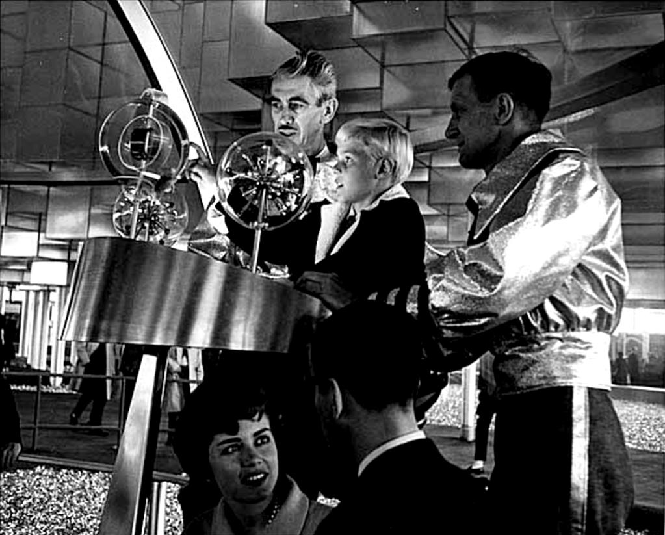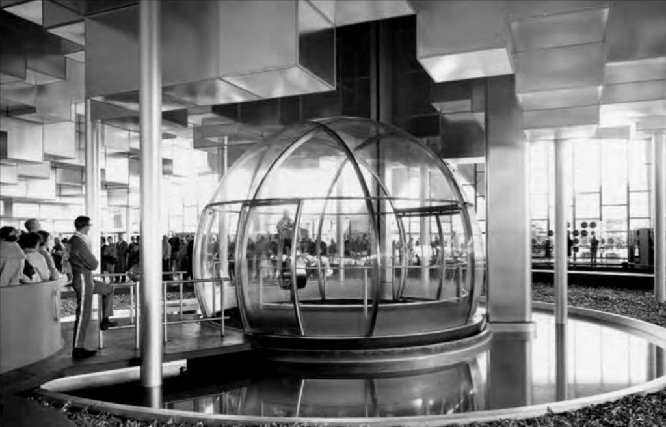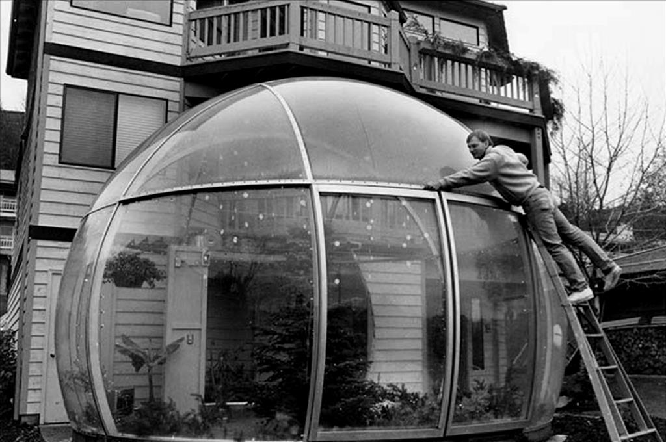The Bubbleator at Seattle Center Carries its Final Passengers on October 1, 1980
September 30, 2024 at 5:23 p.m.
On October 1, 1980, the bubble-shaped plexiglass elevator known as the Bubbleator, which carried millions of visitors between floors at the Washington State Coliseum during the 1962 Seattle World’s Fair, transports its final passengers. The 19-foot-diameter, 3,000-pound hydraulic elevator was built for the World of Tomorrow exhibit at a cost of $65,000. After the fair ended, the structure was re-installed in the Food Circus, today known as the Armory, where it ran between three floors, but a planned renovation to the building excluded the Bubbleator. It was put up for public auction but drew no bids. The structure was donated to Children’s Hospital with the hope it could be incorporated into a play area. When that idea fell through, the Bubbleator was disassembled and stored in a warehouse on Lake Union. In 1985, Seattle Post-Intelligencer staffer Gene Achziger paid $1,000 for the Bubbleator, moved it to Des Moines, and incorporated it into his home as a greenhouse.
"Step to the Rear"
The 1962 Seattle World’s Fair was a showcase of futuristic buildings, transportation systems, and twenty-first century living. One of the most popular attractions was the Bubbleator, a 19-foot-diameter plexiglass elevator that transported an estimated 2.5 million visitors 28 feet between floors at the Washington State Coliseum’s Worlds of Tomorrow exhibit. Its aluminum structure was built by Seattle Bronze. Plastic Products Company made the plexiglass panels, and Montgomery Elevator built and installed the lift device. The cost was estimated at $65,000.
 Actor Jay North (Dennis the Menace) at Bubbleator controls, Seattle, 1962, photo courtesy MOHAI (1965.3598.15.26)
Actor Jay North (Dennis the Menace) at Bubbleator controls, Seattle, 1962, photo courtesy MOHAI (1965.3598.15.26)
The Bubbleator could accommodate 100 passengers at a time and ran every 2 minutes and 40 seconds. The elevator operator was dressed in a sparkly silver-and-green outfit and was visible sitting in a stainless-steel chair surrounded by controls. A disembodied voice delivered a welcoming statement: "Please step to the rear of the sphere, we can only accommodate a hundred of you … a century at a time … First floor! Threats and thresholds, frustrations and fulfillments, challenges and opportunities. First floor! Step off into the future, please!” (Banel)
 Fairgoers waiting to ride Bubbleator, Century 21, Seattle, April 25, 1962, photo courtesy UW Special Collections
Fairgoers waiting to ride Bubbleator, Century 21, Seattle, April 25, 1962, photo courtesy UW Special Collections
A Move to the Food Circus
After the fair closed in October 1962, the city remodeled the Coliseum into an events venue and needed to off-load the Bubbleator. In November 1962, the state sold the structure to the City of Seattle for $5,100. The Bubbleator was moved to the Food Circus, known today as the Armory, where it continued to draw crowds. At the Food Circus, the elevator rose between three floors. Decorations inside the sphere transformed the globe into a pumpkin at Halloween and a snowman at Christmas. Santa Claus took up residence in the Bubbleator during the holidays, posing for pictures with children.
Although it continued to be a popular feature, particularly with children, a hydraulic leak in the mid-1970s forced the Bubbleator to shut down. The Food Circus was scheduled for renovation and once again, plans did not include the Bubbleator. On October 1, 1980, the Bubbleator carried its last passengers.
On the Auction Block
A surplus auction for the Bubbleator drew no bidders, and the structure was donated to Children’s Hospital with the hope it could be turned into a playground feature. The idea never materialized and the Bubbleator was disassembled and stored in a warehouse on Lake Union. That’s where Gene Achziger found it in 1985.
Achziger, a copy editor at the Seattle Post-Intelligencer, was asked by fellow P-I journalist and columnist Jean Godden to find out what had happened to the Bubbleator. He tracked it down to the Lake Union warehouse. Struck by its history, Achziger paid $1,000 for the heap of metal and plexiglass, put the pieces on a flatbed truck, and took it to his parents’ home in University Place. "In the process of researching it, I realized that it was, you know, an icon ... It was there, it looked like, 'Hey this could be interesting.' It is a piece of history" (Banel.)
In 1987, he transported the Bubbleator to a house he was building in Des Moines, and converted it into a greenhouse, which was attached to the front of his home. There it has sat for 35 years and counting. "Only the top two-thirds of the Bubbleator remained. There was no floor, no motor" (Phinney).
 Gene Achziger with his Bubbleator greenhouse, Des Moines, December 8, 1988, courtesy MOHAI (2000.107.002.14.01)
Gene Achziger with his Bubbleator greenhouse, Des Moines, December 8, 1988, courtesy MOHAI (2000.107.002.14.01)
Unfortunately, the bubble shape was not conducive to gardening; the structure magnified the sun and scorched the plants. "Achziger did have an exhaust system going through the concrete pad on which The Bubbleator sits, but the water table on his property has risen and it fills the exhaust pipe. He has thought of drilling through the acrylic panels but worries they’ll shatter because they’re so old. Except for decorating The Bubbleator with lights during the holidays, it sits empty" (Lacitis).
The sphere had good acoustics, though, and in 2012, Achziger allowed a local music group, Trip Like Animals, to tape an EP (extended-play record) within the sphere. Elected to the Des Moines City Council, Achziger is serving on the city’s transportation committee through 2023.
The Bubbleator’s operator chair was accessioned by Seattle’s Museum of History and Industry in 2005, and private collectors have squirreled away some of the sparkly uniforms worn by the elevator operators. When asked about the future of the Bubbleator, Achziger explained the challenges inherent with its removal: "It’s built into the house, so if it was to move, I’ve got a big hole to fill. I think a lot of the community is used to it being here, so I would probably get as much flak for moving it as they did in Seattle" (Banel).
Sources: (This article was originally posted on the HistoryLink website on 10/30/2022: The Bubbleator at Seattle Center carries its final passengers on October 1, 1980. - HistoryLink.org)
Susan Phinney, "Century 21 Remnants Found New Homes," Seattle Post-Intelligencer, April 15, 2002 (www.seattlepi.com); Feliks Banel, "Bubbleator was Seattle’s Original Sphere of Influence," MyNorthwest, January 29, 2018 (https://mynorthwest.com/883758/bubbleator-original-sphere/); Erik Lacitis, "How Seattle Pulled Together Plans, People, Elvis, and The Bubbleator to Put on the 1962 World’s Fair," The Seattle Times, April 15, 2022 (www.seattletimes.com); "Historic Bubbleator Gets Renewed Attention in New Seattle Channel Video," South King Media blog post, August 5, 2021, website accessed October 24, 2022 (https://waterlandblog.com/2021/08/05/historic-bubbleator-gets-renewed-attention-in-new-seattle-channel-video/); "The Bubbleator Sessions, Vol. 1: Trip Like Animals," YouTube video posted by Scott Schaefer, November 7, 2012 (https://www.youtube.com/watch?v=GfuoLYUaqhw).





